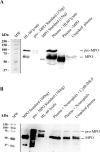A myeloperoxidase precursor, pro-myeloperoxidase, is present in human plasma and elevated in cardiovascular disease patients
- PMID: 29590135
- PMCID: PMC5873943
- DOI: 10.1371/journal.pone.0192952
A myeloperoxidase precursor, pro-myeloperoxidase, is present in human plasma and elevated in cardiovascular disease patients
Abstract
Myeloperoxidase (MPO)-derived oxidants have emerged as a key contributor to tissue damage in inflammatory conditions such as cardiovascular disease. Pro-myeloperoxidase (pro-MPO), an enzymatically active precursor of myeloperoxidase (MPO), is known to be secreted from cultured bone marrow and promyelocytic leukemia cells, but evidence for the presence of pro-MPO in circulation is lacking. In the present study, we used a LC-MS/MS in addition to immunoblot analyses to show that pro-MPO is present in human blood plasma. Furthermore, we found that pro-MPO was more frequently detected in plasma from patients with myocardial infarction compared to plasma from control donors. Our study suggests that in addition to mature MPO, circulating pro-MPO may cause oxidative modifications of proteins thereby contributing to cardiovascular disease.
Conflict of interest statement
Figures






Similar articles
-
Plasma concentrations of myeloperoxidase predict mortality after myocardial infarction.J Am Coll Cardiol. 2007 May 22;49(20):1993-2000. doi: 10.1016/j.jacc.2007.02.040. Epub 2007 May 4. J Am Coll Cardiol. 2007. PMID: 17512353
-
High plasma thiocyanate levels are associated with enhanced myeloperoxidase-induced thiol oxidation and long-term survival in subjects following a first myocardial infarction.Free Radic Res. 2014 Oct;48(10):1256-66. doi: 10.3109/10715762.2014.947286. Free Radic Res. 2014. PMID: 25050609
-
Elevated levels of myeloperoxidase, white blood cell count and 3-chlorotyrosine in Taiwanese patients with acute myocardial infarction.Clin Biochem. 2008 May;41(7-8):554-60. doi: 10.1016/j.clinbiochem.2008.02.006. Epub 2008 Feb 20. Clin Biochem. 2008. PMID: 18314009
-
Myeloperoxidase As a Multifaceted Target for Cardiovascular Protection.Antioxid Redox Signal. 2020 May 20;32(15):1135-1149. doi: 10.1089/ars.2019.7971. Epub 2020 Mar 6. Antioxid Redox Signal. 2020. PMID: 31847538 Review.
-
Myeloperoxidase: a leukocyte-derived protagonist of inflammation and cardiovascular disease.Antioxid Redox Signal. 2013 Feb 20;18(6):692-713. doi: 10.1089/ars.2012.4783. Epub 2012 Oct 3. Antioxid Redox Signal. 2013. PMID: 22823200 Review.
Cited by
-
Oxidative cross-linking of calprotectin occurs in vivo, altering its structure and susceptibility to proteolysis.Redox Biol. 2019 Jun;24:101202. doi: 10.1016/j.redox.2019.101202. Epub 2019 Apr 13. Redox Biol. 2019. PMID: 31015146 Free PMC article.
-
Novel iodoquinazolinones bearing sulfonamide moiety as potential antioxidants and neuroprotectors.Sci Rep. 2023 Sep 20;13(1):15546. doi: 10.1038/s41598-023-42239-2. Sci Rep. 2023. PMID: 37730974 Free PMC article.
-
Hyper-truncated Asn355- and Asn391-glycans modulate the activity of neutrophil granule myeloperoxidase.J Biol Chem. 2021 Jan-Jun;296:100144. doi: 10.1074/jbc.RA120.016342. Epub 2020 Dec 10. J Biol Chem. 2021. PMID: 33273015 Free PMC article.
-
Inflammatory Markers Related to Innate and Adaptive Immunity in Atherosclerosis: Implications for Disease Prediction and Prospective Therapeutics.J Inflamm Res. 2021 Feb 16;14:379-392. doi: 10.2147/JIR.S294809. eCollection 2021. J Inflamm Res. 2021. PMID: 33628042 Free PMC article. Review.
-
Differential gene expression patterns in ST-elevation Myocardial Infarction and Non-ST-elevation Myocardial Infarction.Sci Rep. 2024 Feb 10;14(1):3424. doi: 10.1038/s41598-024-54086-w. Sci Rep. 2024. PMID: 38341440 Free PMC article.
References
-
- Harrison JE, Schultz J. Studies on the chlorinating activity of myeloperoxidase. J Biol Chem. 1976;251(5):1371–4. . - PubMed
-
- Senthilmohan R, Kettle AJ. Bromination and chlorination reactions of myeloperoxidase at physiological concentrations of bromide and chloride. Arch Biochem Biophys. 2006;445(2):235–44. doi: 10.1016/j.abb.2005.07.005 . - DOI - PubMed
-
- Klebanoff SJ. Myeloperoxidase: friend and foe. J Leukoc Biol. 2005;77(5):598–625. doi: 10.1189/jlb.1204697 . - DOI - PubMed
-
- Furtmuller PG, Jantschko W, Regelsberger G, Jakopitsch C, Moguilevsky N, Obinger C. A transient kinetic study on the reactivity of recombinant unprocessed monomeric myeloperoxidase. FEBS Lett. 2001;503(2–3):147–50. Epub 2001/08/22. . - PubMed
Publication types
MeSH terms
Substances
LinkOut - more resources
Full Text Sources
Other Literature Sources
Research Materials
Miscellaneous

